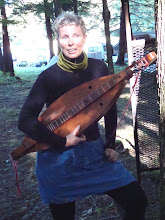
This is the THIRD of several posts devoted to a VERY SIMPLE beginner level review of how to play in the most common modes.
Remember, the first mode we used in this little series of posts was the mixolydian mode. In the mixolydian mode, key of D, your Do-Re-Mi scale starts with the D tonic "1" note on the OPEN (zero fret) of the melody strings. Your strings were tuned DAD to be in mixolydian mode in the key of D.
By the way- when we write the tuning such as DAD, it's most common to list the strings from bass string to melody string. Thus, the last 'D' when referring to 'DAD' means your melody string(s). Some people have one melody string, some have a pair, but the pair is tuned as though it were one string, so when we say DAD, the last D means how you tune your single or your pair of melody strings.
As we go through the four common modes one at a time, we'll be doing it in a logical order by moving our tonic "1" note, our 'home base' note, up the fingerboard a little more for each mode. We are staying in the same key of D, but are locating our 'home base' in different places on the fretboard, where we will have varying fret patterns in our scale.
That's why I started with mixolydian scale, where the 'home base' tonic note is on the open string, also known as the 'zero' fret...
So, the four modes have the following places where their 'home base' tonic note is:
Mixolydian mode= 0 fret (open string)
Aeolian mode= 1st fret
Ionian mode= 3rd fret
Dorian mode= 4th fret
Talking now in the key of D where the D note is your tonic 'home note'- to make the tonic D note's location be on a higher fret, you have to lower the pitch of the string. This is an important concept- read that sentence again.
Starting in mixolydian DAD, where the melody string's D is on the open string... if we want to change to aeolian mode and have the tonic D note on the first fret instead of the zero fret, we must LOWER the tuning of our open melody string from D to C. Use your electronic tuner, and lower your melody string from D to C. See this chart for how your dulcimer will be tuned in aeolian mode for the key of D:
 Now you are tuned DAC (C being your melody string). Notice again we are not changing the tuning of your other (drone) strings at all. I'll talk about why that is at the end of this series of posts- it's easy!
Now you are tuned DAC (C being your melody string). Notice again we are not changing the tuning of your other (drone) strings at all. I'll talk about why that is at the end of this series of posts- it's easy!Now, if you would, go back and re-read my first post about playing in the aeolian mode: The Beautiful Aeolian Mode. Try playing Shady Grove, it's really a simple tune to play! If you didn't understand much of what I wrote before, re-reading that Aeolian post might make a bit more sense to you now. If you don't 'get' some of the concepts don't worry- just the practice of going back and forth between mixolydian DAD and aeolian DAC tunings will get you where you need to go and get you more comfortable with the idea of re-tuning to various modes.
To review-
We've now gotten through two of the four most common modes: mixolydian based on the zero fret, and aeolian based on the 1st fret.
For my next post I'll take a brief break from the four mode series to write up a tab for one of my personal favorite traditional songs that can be played in the haunting aeolian mode tuning...Wedding Dress...also known as Doney Gal or Little Doney Gal (as I like to call it). This song is very simple to play and it really shines using open drones. Be sure to try it- it's quite an addictive beautiful song. I usually play it on my banjo in A modal tuning, but I'll create an aeolian dulcimer tab for it so you can play it too! After that I'll return to the mode series and move on to the Ionian mode, home-based on the 3rd fret.
continue reading the rest of this post here...


